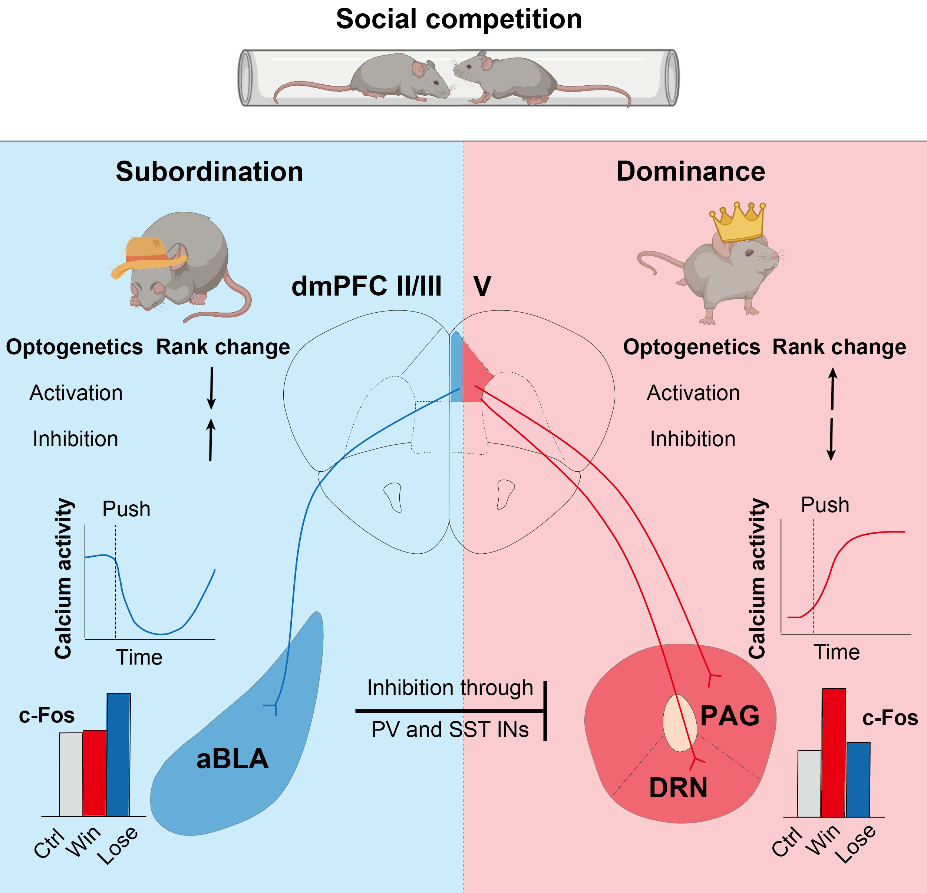HU Hailan's group published in Neuron on neural mechanism underlying social hierarchy
The research team led by Prof. Hailan Hu has recently published an article titled Deconstructing the neural circuit underlying social hierarchy in mice on Neuron online on Dec 10th, 2024. This research revealed the antagonistic interplay between win-related and lose-related dmPFC downstream pathways in mediating social competition.
Social competition determines hierarchical social status, which profoundly influences animals’ behavior and health. The dorsomedial prefrontal cortex (dmPFC) plays a fundamental role in regulating social competitions, but it was unclear how the dmPFC orchestrates win- and lose-related behaviors through its downstream neural circuits. Here, we dissected the individual contribution and reciprocal interaction of dmPFC downstream circuits in modulating dominance behavior. Brain-wide c-Fos mapping experiment revealed that winner mice in the tube test competition exhibited a significantly higher number of c-Fos-positive neurons in the dmPFC downstream targets, including the DRN and PAG, whereas loser mice exhibited more c-Fos-positive neurons in the aBLA. Consistently, pathway-specific manipulations outlined a dmPFC-centric social dominance neural network, in which the dmPFC-DRN and dmPFC-PAG circuits act as win-related pathways, whereas the dmPFC-aBLA circuit acts as a lose-related pathway. Moreover, the activation or inhibition of the aBLA itself yielded similar effects as manipulation of the dmPFC-aBLA pathway. Accordingly, these win- and lose-related dmPFC circuits showed opposing calcium activities when mice initiated ‘‘effortful’’ push behaviors in the tube test competition. Retrograde tracing study revealed that these functionally divergent pathways are anatomically segregated, with the lose-related aBLA-projecting neurons located in the layer 2/3 and the win-related DRN- and PAG- projecting neurons located in the layer 5 of the dmPFC. Finally, using in vivo and in vitro electrophysiological recordings, we found an inhibition from the lose-related neurons to the win-related neurons through local PV and SST interneurons in the dmPFC. One interesting speculation of the function of this unidirectional interaction is that losing mentality may dominate over winning during competitions: once animals initiate the idea of quitting or withdrawing from the rivalry, the inhibition on the win pathway from the lose pathway would help them execute the idea and end the fight quickly. Such antagonistic interplay may represent a central principle in how the mPFC orchestrates complex behaviors through top-down control.

dmPFC-centric social dominance neural network
https://www.cell.com/neuron/abstract/S0896-6273(24)00807-9
HAILAN HU'S RESEARCH GROUP: For social animals, emotions and health are regulated by various social behaviors. Hailan Hu's group is dedicated to studying the neural basis and plasticity mechanisms of emotion and social behavior. They use cutting-edge techniques including imaging, electrophysiology (both in vitro and in vivo), molecular genetics, and optogenetics to conduct deep analysis of emotion- and social behaviors- and their related neural circuits.







